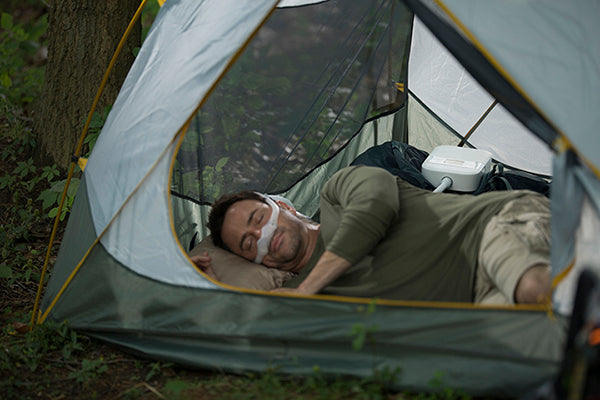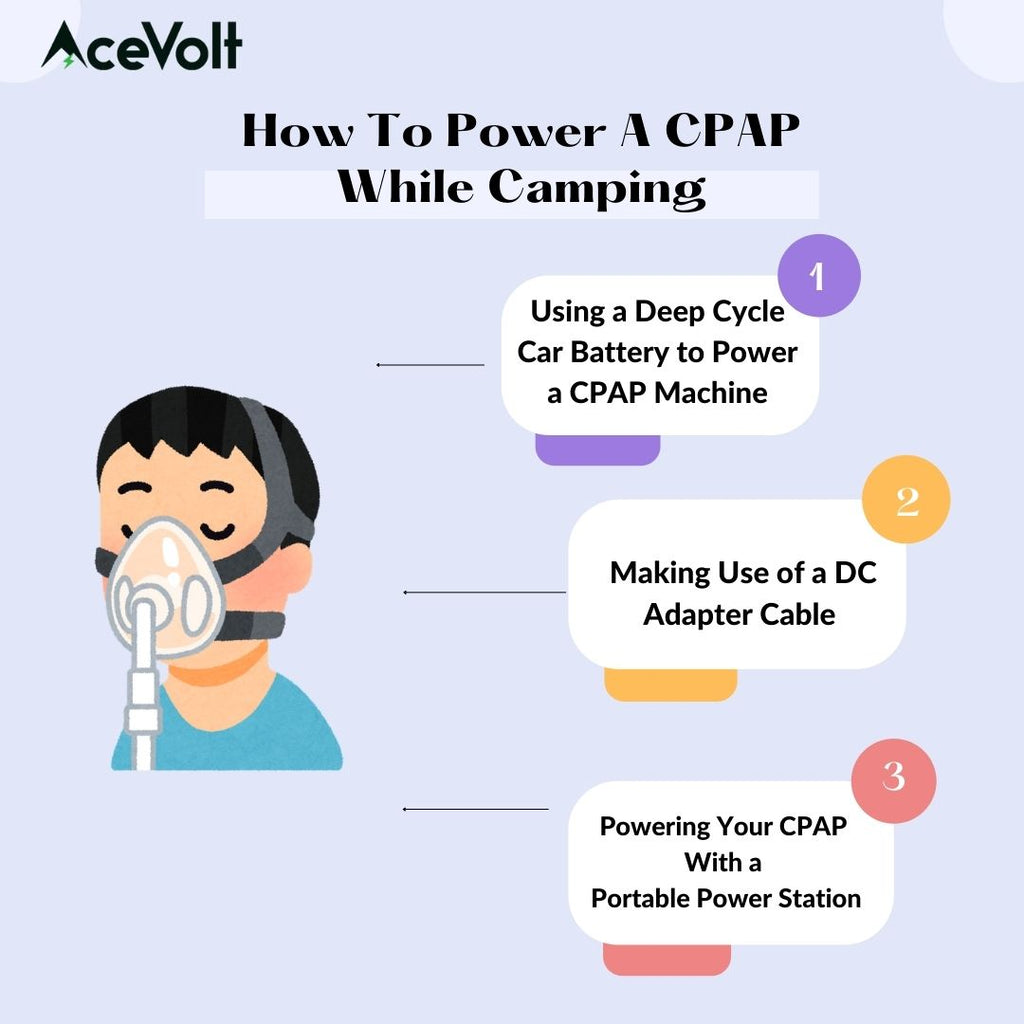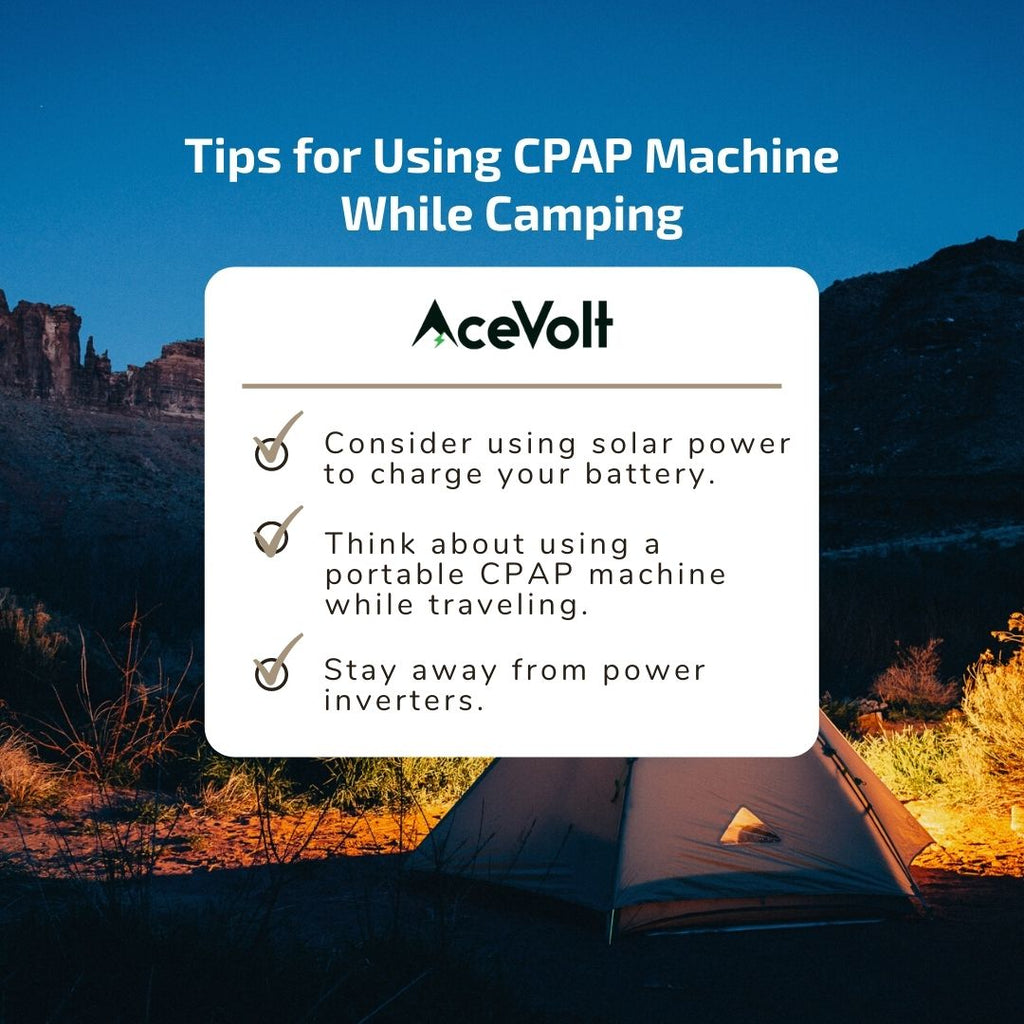
How to Power Your CPAP Machine While Camping
A portable CPAP machine is something you might find in the backpacks of 1 in 12 American adults should they go camping. According to the American Journal of Epidemiology, sleep apnea is a condition that 26 percent of adults face.
Obstructive sleep apnea (OSA) causes breathing disruptions or pauses, which occur when your throat or airways collapse or become momentarily blocked.
The easiest way to manage sleep apnea is with a CPAP machine. And if you want to go camping, even off-the-grid camping, sleep apnea doesn't have to stop you. This article provides helpful tips on using a CPAP machine while camping.

What is a CPAP Machine?
The most widely prescribed equipment for treating sleep apnea disorders is a continuous positive airway pressure (CPAP) machine.
How does the CPAP machine work?
The machine delivers a continuous stream of clean oxygen to your nose and mouth as you sleep.
The airstream from the CPAP machine pushes against any obstructions in your airways while you sleep. Doing so helps you breathe appropriately since nothing is blocking oxygen flow. As a result, you don't have to wake up every time you stop breathing.

How To Power A CPAP While Camping
Almost all CPAP devices are powered by a power supply that plugs into an electrical outlet. As a result, most CPAP machines do not require batteries. However, sometimes, sleepers need a battery-powered CPAP machine for camping. For example, if you're going on a camping trip, you'll require a travel CPAP machine, and most of these can be powered by a battery.
CPAP batteries can always be used as a backup power source in a power outage, but only for a limited time. The majority of CPAP battery packs will last one to two nights before needing to be recharged.
You might want to consider obtaining additional batteries if you plan on traveling or hiking deep into the woods or up a mountain. However, because good CPAP batteries are expensive (and you want to invest in ones that will last for years), unless you can afford it, you can rely on a portable power supply with an outlet and one battery that will serve for backups or emergencies.
Batteries allow you to go wherever you choose.
While camping off the grid, you have two options for powering your CPAP:
You can either use an adapter to attach the CPAP into a car battery or buy a portable power source for your CPAP machine, such as a AceVolt solar generator.
-
1. Using a Deep Cycle Car Battery to Power a CPAP Machine
Yes, you read that correctly. A car battery can power some portable CPAP machines. You can purchase car batteries at auto parts stores or large retail outlets in your area. Car batteries are deep-cycle lead-acid batteries with substantially higher capacity than lithium-ion batteries. As a result, it's possible to get enough juice to last for days.
To make it function, you'll need to obtain a DC adapter cable and connect it to the DC cable on your machine.
-
2. Making Use of a DC Adapter Cable
Alligator clips connect the positive and negative ends of the deep-cycle battery on a DC Adapter Cable. The power is then delivered to a cigarette lighter plug. After that, you may plug your machine's DC cord into the cigarette lighter plug and use it to power it. Some deep-cycle batteries have a built-in cigarette lighter plug, letting you plugin without the need for an adaptor.
However, Using a car battery for your CPAP has some disadvantages:
Car Batteries are cumbersome to lug around in a backpack over long distances.
The FAA disapproves of Deep Cycle Batteries.
This leaves us with a better option: using a portable solar power station to power your portable CPAP for camping.
-
3. Powering Your CPAP With a Portable Power Station
You can't go wrong with a portable solar generator when it comes to camping with a CPAP machine.
One of the best solar-powered generators for camping is the Acevolt Campower, and it can be a valuable, portable tool for charging your CPAP.
The best thing is it has fast charging abilities. Therefore, in as little as 3 hours, your portable power station can be up and running, providing you with hours of charging your equipment, CPAP included.
The AceVolt 700 Portable Power Station is a beautiful off-grid power solution because it only weighs 22 lbs. The AceVolt solar battery has a capacity of 700 watts and 672 watt-hours, allowing you to comfortably run a 30-watt CPAP machine for over 22 hours while camping. In optimum conditions, the battery may be entirely recharged in 3-4 hours when charged using a 200 Watt solar panel! Plus, the AceVolt's battery is rated for 2,500+ cycles, so it'll keep you going for years.

Tips for Using CPAP Machine While Camping
-
Tip 1: Consider using solar power to charge your battery.
Solar charging can be a game-changer for those who spend a lot of time outside and off the grid.
Solar panels may charge the battery while you're hiking and enjoying the great outdoors, and the battery will be ready for another night of therapy when you return to camp at night. Solar panels can increase your range and allow you to spend more time in the woods.
AceVolt generators offer a range of some of the best portable solar panels for off-grid living. They are quite portable too, so they won't be much trouble moving around while camping.
-
Tip 2: Think about using a portable CPAP machine while traveling.
If you're going camping, a travel-sized CPAP machine that fits into compact locations (like a backpack) and is light enough not to add too much weight is a good idea. This makes it more portable, allowing you to bring more gear than if you utilized a home unit.
- When compared to home CPAPs, most travel CPAPs offer the following benefits:
- You'll have a machine for both your home and your travels.
- Using your machine in a car or on a plane will be easier
- Advanced features are embedded in Travel Machines
- While no CPAP with a built-in battery is currently available, many users find that using a travel machine and a travel battery works just fine.
-
Tip 3: Stay away from power inverters.
Why is it that utilizing an inverter is such a horrible idea? Inverters rely on battery power to convert from DC to AC. As a result, not only is the machine getting power from the battery, but the inverter is as well. This can cause the battery to deplete twice as quickly as if you didn't use one. Using an inverter is sometimes inevitable. Some machines are not DC competent and will require an AC power supply, which will necessitate the conversion of a battery to AC power.
Finding a CPAP battery for camping that is made precisely for your equipment is the best method. For example, one that includes a cable that connects directly. It will not require a power inverter and, as a result, will charge the battery for a more extended period.
Conclusion
As you can see, there are various methods to explore beautiful nature while still maintaining your CPAP therapy. So don't fall into the temptation to skip your therapy while you're gone. Doing so may leave you with little energy, and your trip may be less enjoyable.
We hope you've picked up some tips and ideas to help you have a great time on your next camping trip!
Related Product























Leave a comment